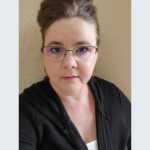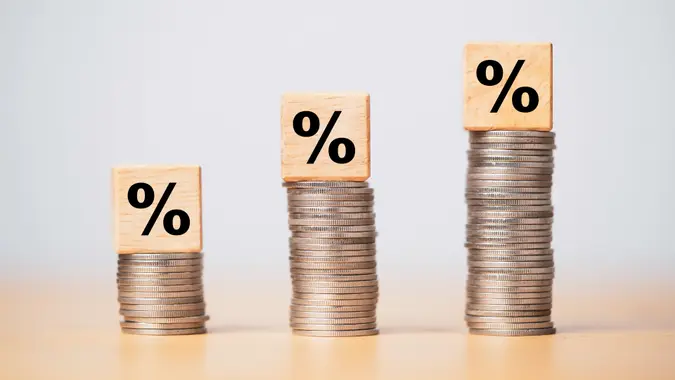How Many Savings Accounts Should I Have?

Commitment to Our Readers
GOBankingRates' editorial team is committed to bringing you unbiased reviews and information. We use data-driven methodologies to evaluate financial products and services - our reviews and ratings are not influenced by advertisers. You can read more about our editorial guidelines and our products and services review methodology.

20 Years
Helping You Live Richer

Reviewed
by Experts

Trusted by
Millions of Readers
The right number of accounts for you depends mostly on what you’re saving for. If, for example, you want an emergency fund but plan to invest the rest of your spare cash through a brokerage account, one savings account may be all you need. If, on the other hand, you have multiple goals, consider opening a separate account for each.
Why You Might Need Multiple Savings Accounts
Not everyone needs multiple savings accounts, but they’re a good idea for anyone who has more than one goal for the money they save. Having multiple accounts could make it easier to set a budget for meeting each of those goals and reduce the temptation to withdraw money prematurely.
Your savings goals might include:
- Emergency fund
- Rainy day fund
- New car
- Down payment for a home purchase
- Home improvements
- Large purchases such as furniture or expensive electronics
- Vacation
- Expenses you pay infrequently, such as property tax, car registration and professional fees
- Children’s education
- Retirement
Benefits of Having More Than One Savings Account
Having multiple savings accounts can provide a strategic edge in managing your finances. Here’s how dividing your funds can work to your advantage:
1. Organize Funds by Financial Goals
Assigning each savings account to a specific financial goal can simplify your money management. For example, one account could serve as your emergency fund, while another is dedicated to your dream vacation or a future home purchase. This separation ensures clarity and reduces the temptation to dip into funds meant for other purposes.
2. Better Tracking and Focus
With a dedicated account for each goal, it’s easier to monitor your progress and stay motivated. You’ll know exactly how close you are to reaching milestones like building a six-month emergency fund or saving for a special getaway. This focused approach can help you avoid feeling overwhelmed and keep your financial goals on track.
3. Leverage Different Interest Rates or Benefits
Different savings accounts offer varying features, such as higher interest rates, lower fees, or cashback benefits. By spreading your funds strategically, you can take advantage of these perks. For example, you might keep your emergency fund in a high-yield savings account to maximize growth while using a more accessible account for short-term goals.
How to Decide How Many Savings Accounts You Need
When deciding how many savings accounts to open, it’s important to balance your financial goals with practicality.
Key Factors to Consider
- Define Your Financial Goals. Separate accounts for short-term needs (vacations, shopping) and long-term goals (home purchase, retirement) help you stay organized and focused.
- Assess Income and Savings Capacity. Your ability to save determines how many accounts are practical. Prioritize key goals if your budget is tight.
- Evaluate Costs and Management. Watch for fees or minimum balance requirements and ensure you can easily manage multiple accounts with online tools.
- Insurance limits: FDIC and NCUA only cover your account up to $250,000. If you have more than that in your account, you should consider opening another one.
Tailoring your accounts to your goals and budget ensures an efficient and effective savings strategy.
Pros and Cons of Multiple Savings Accounts
There are several things to consider before you open another savings account:
| Pros | Cons |
|---|---|
| Protect your savings from your spending | Maintenance fees |
| Clearer financial planning | Sometimes top rates require high balances |
| Take advantage of accounts with higher interest rates | Can be more difficult to track |
Tools and Tips for Managing Multiple Savings Accounts
Managing multiple savings accounts might sound like a hassle but here are a few tips to help make it a cinch:
- Use multiple banks: If you are saving for different goals, it can be a good idea to use multiple banks for your accounts. This can help keep your regular monthly spending accounts and your long-term savings accounts separate.
- Automate your savings: Most savings accounts allow you to set up recurring deposits. This means you can deposit a set amount on a schedule — automating your savings goals across multiple savings accounts.
- Use a finance app: When you have multiple savings accounts and different banks, keeping track may feel cumbersome. But finance apps allow you to connect all of your bank accounts and track all of your finances in a single dashboard. This can help give you clarity on how you’re progressing toward your financial goals.
FAQ
Here are quick answers to common questions about savings accounts.- Is it a good idea to have multiple savings accounts?
- Keeping all your money in one account may keep things simple but having multiple savings accounts has benefits. If you don't always stay on top of your budget, keeping savings for individual financial goals -- especially emergency savings -- in separate accounts can help ensure you don't use the money for other purposes.
- How many savings accounts are ideal?
- The number of savings accounts you choose depends on your financial goals and personal circumstances. While some individuals might be ok with a single savings account, it can be good to split up your savings into different accounts for different goals.
- How many bank accounts should I have for savings?
- It’s a good idea to have one savings account for each savings goal. This might mean opening multiple accounts for goals like your emergency fund, house down payment, holidays, vacation and other goals.
- Is $100,000 too much to have in a savings account?
- Holding $100,000 in a savings account is fine in most cases. Most savings accounts are FDIC insured up to $250,000. But it might make sense to consider alternatives once you've established an emergency fund and are making good progress on your other savings goals. Investing your excess savings in a brokerage account, for example, can earn you a better return on your money.
Barri Segal, Jacob Wade and Daria Uhlig contributed to the reporting for this article.
Our in-house research team and on-site financial experts work together to create content that’s accurate, impartial, and up to date. We fact-check every single statistic, quote and fact using trusted primary resources to make sure the information we provide is correct. You can learn more about GOBankingRates’ processes and standards in our editorial policy.
- FDIC. "Deposit Insurance FAQs."
- Northwestern Mutual. "Planning & Progress Study 2022."
- Vanguard. "What's the right emergency fund amount?"
- Forbes. "How Many Savings Accounts Should I Have?"
 Written by
Written by  Edited by
Edited by 

























